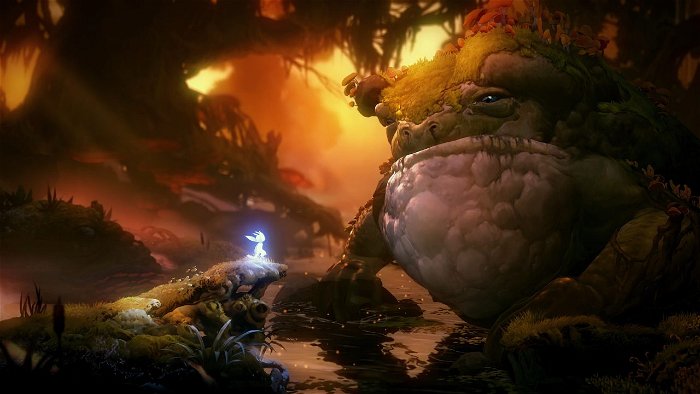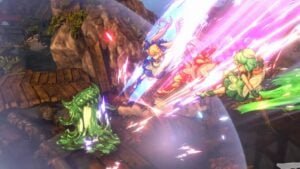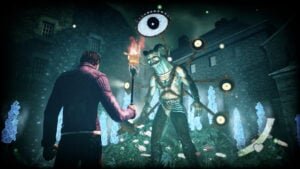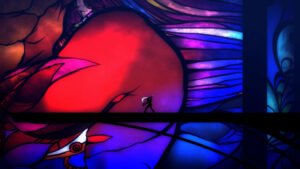Moon Studios have built a name for themselves has one of the top indie studios currently working on gaming. Bringing the Ori games current gaming platforms has shown the potential of what could be done with an attention to detail, a drive to build stories, and working with a team that has a love of the subject.
With this core viewpoint and some of the most stunning art in the indie space, Moon Studios have taken the art and music as some core elements at the centre of the Ori franchise. The blending of the audio visual experience makes Ori a unique and exciting game. With it now on the Nintendo Switch, CGMagazine decided to take time to talk to the series lead artists Daniel van Leeuwen and Jeremy Gritton about the creative process along with how these two artistic elements work together to craft the stunning final product.

CGMagazine: How did you find inspiration for Ori?
Jeremy: Since Will of the Wisps is a sequel, and we were taking the reins as a new art team, our primary source of inspiration was the original game – Ori and the Blind Forest. We spent a lot of time deconstructing Blind Forest to understand the decision-making that went into the art style.
We paid attention to things like colour palette, shape language, environmental storytelling, gameplay readability, composition, and how the game scenes direct the player toward the intended goals. Cinematically, we studied the visual storytelling methods that were used – narration text, when and how to take control away from the player, and the editing.
Blind Forest’s art style was heavily inspired by the works of Studio Ghibli and by extension Will of the Wisps’ was as well, but that primarily happened through our intricate study of the original game. Additionally, while we wanted to stay true to the vision of Blind Forest, we had a team of artists bringing their own stylistic preferences to the project. Our goal was to blend new ideas into what was already established to create something similar but fresh.
CGMagazine: Do you have influences you draw on to help shape the look and sound of the game?
Daniel: The real world is one of the biggest influences to be honest. The scale at which the world of Ori is represented is an interesting mix of the big and the small. Just walking around in nature you might appreciate a forest as a whole, but looking down at the details that are everywhere, the little nooks and crannies, represent an entirely different perspective, the world at the level of insects and small birds.
Many themes in the bigger world seem to have some alternate representation in that small world; you can have big sand dunes in a desert but similarly those sand dunes show up as miniature ones on a beach, zooming in at the level and imagining what your looking at is the large scale world can give a lot of inspiration, and you can find it everywhere you go.

CGMagazine: Are there areas of the series that feel best showcase a blending of art and audio?
Jeremy: Every piece of the game benefits from the synergy between all of our departments, and how art and audio work together to craft a cohesive experience is no exception. There are many good examples, but a specific one that comes to mind is the Mouldwood Depths.
There is an all-encompassing darkness in the environment and if the darkness begins to close in around Ori, the audio perfectly matches the claustrophobic feeling. The visuals and audio pair very nicely together for that specific sense of dread when the darkness is about to overwhelm the player.
The music is also perfectly oppressive, selling the creepy vibe of the entire area.
CGMagazine: What about Ori will you bring into other projects moving forward?
Daniel: We at Moon value a strong art direction. We want to craft experiences that will still be appreciated many years from now, and we think that non-realistic art styles can stand the test of time much longer, they don’t feel outdated as fast as games that pursue realism so that’s definitely one of the core things that we’ll take with us for future projects.
Next to that a lot of our designers also got very experienced with level design, this is definitely one of the things that will flow into other projects. We want to continue creating interesting and hand crafted spaces that are memorable and just cool to explore. We don’t feel like going down the road of auto-generated content, it’s not where our heart lies.

CGMagazine: What do you think gaming adds to the artistic process, and do you believe this feeling could be replicated in another medium?
Jeremy: What gaming provides that no other medium can is truly putting the player in the position of the protagonist. With a book or a movie, we always function as an observer to the protagonist’s story, which creates a degree of separation. Even if a book is written in first person, it’s not quite the same. It helps us understand the protagonist’s inner-most thoughts and see things from their point-of-view, but we’re still passive in the sense that we cannot actively control what happens – we can only continue to read and observe.
In a game the player is in control of their game avatar (in our case Ori) which immediately creates a sense of attachment that isn’t otherwise possible. Having that control creates a different feeling of identification to the character. We actually made sure to give the player some opportunities to control Ku alongside Ori with a tandem controller for this exact reason.
Beyond that, a game provides the player the ability to go off the beaten path, explore, find secrets, and otherwise dig into the world that is presented to them. Having that freedom creates a sense of appreciation for the world that’s being presented, because you have the ability to spend as much or as little time as you like in the areas that capture your imagination.
CGMagazine: Indie games are now more stunning and complex than ever – do you see this trend continuing moving forward, and if so, do you believe Ori had a part in helping this trend continue?
Daniel: I think indie games still have a very bright future ahead. All the software for creating them is quickly becoming more and more accessible, in some cases completely free. Next to that there are a lot of great and free learning resources out there on the web right now. It’s becoming easier and easier to make a game by yourself and with young generations growing up in this world I can’t see how that won’t result in a bigger wave of indie titles in the future.

I think Moon Studios has been a great example for showing that you can make solid titles with a distributed studio. With a lot more people working from home and getting a taste of it, I can very easily see how some studios will also make the jump and go completely distributed. This is a great opportunity, especially for Indies. You can work together from anywhere in the world, you just need to find some like-minded people and make it work.
CGMagazine: How did the art team and audio team work together for Ori, and do you think other studios could learn anything from this approach?
Jeremy: In our process the Art department typically lays down the foundation for the Audio department, which informs a lot of their decisions. It’s difficult for them to know the intent of the environment or scene without visuals to process and then translate into audio, because of this, environmental audio comes in only later, once the visuals have really started to take shape.
For example, early in the game Ori is lost in the Inkwater Marsh in the middle of a storm. Once the visuals started to come in the audio team was able to gauge just how strong the storm was, where the puddles of water were, and which areas were secluded from the storm instead of exposed to the elements. Another example : Seeing the degree of lightning helped them determine the right kind of accompanything thunder.
Even things like determining the sound created by Ori’s footsteps is driven by the material type – It will sound different if the player is running on grass, stone, wood, or otherwise. Without the visuals providing the context for each area, the audio team wouldn’t be able to properly layer in the right sounds to achieve the final feel. The sound effects provide a really great extra layer of polish to the environments that brings everything to life.

Beyond that, the music in Ori is absolutely critical to the gameplay experience. Gareth Coker’s soundtrack elevates everything in the game, from the gameplay environments to our most emotional cinematic moments. One thing that was a real benefit to us was understanding just how much Gareth’s music adds to those moments – We were always happy to make editing adjustments to our cinematics if he requested them for the benefit of the music. Reaching the correct end result is always about open communication between departments and true back-and-forth collaboration. We made every effort to do that throughout production.




